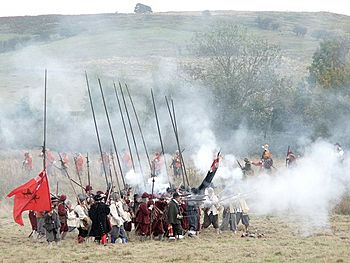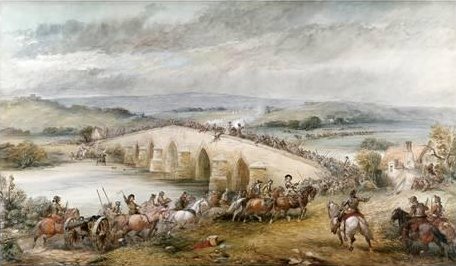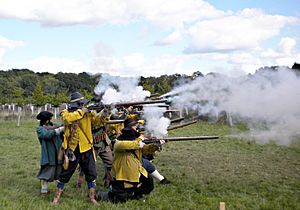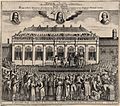Battle of Winwick facts for kids
The Battle of Winwick (also known as the Battle of Red Bank) was a key battle fought on 19 August 1648. It took place near the village of Winwick in Lancashire. This battle was between a Royalist army, which included many Scottish soldiers, led by Lieutenant General William Baillie, and a Parliamentarian army commanded by Lieutenant General Oliver Cromwell.
The Royalist forces were completely defeated. All their foot soldiers were either killed or captured during the fighting. Their horse soldiers managed to escape but surrendered a few days later. The Battle of Winwick was the very last battle of the Second English Civil War.
Quick facts for kids Battle of Winwick |
|||||||
|---|---|---|---|---|---|---|---|
| Part of the Second English Civil War | |||||||
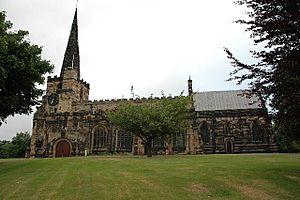 |
|||||||
|
|||||||
| Belligerents | |||||||
| Parliamentarians | |||||||
| Commanders and leaders | |||||||
| Oliver Cromwell | |||||||
| Strength | |||||||
|
|
||||||
| Casualties and losses | |||||||
|
|
||||||
Contents
The Battle of Winwick
The Battle of Winwick was the final major fight of the Second English Civil War. This war was a series of smaller battles and uprisings. It happened after King Charles I was defeated in the First English Civil War.
The King was a prisoner, but he kept trying to make deals with different groups. This led to new rebellions in England and Wales. A Scottish Royalist army also invaded north-west England.
Why the War Started
King Charles I and Parliament
In the 1630s, King Charles I ruled both Scotland and England. He wanted to change the Scottish church to be more like the English one. The Scots did not agree with this.
This led to two short wars called the Bishops' Wars. King Charles I was not successful in these wars. His power in Scotland became much less.
Later, the relationship between King Charles and his English Parliament broke down. This started the First English Civil War in 1642.
The First Civil War Ends
In England, King Charles's supporters were called Royalists. They fought against the Parliamentarians and the Scots. These two groups had formed an alliance.
After four years, the Royalists lost the war. King Charles surrendered to the Scots in 1646. The Scots and the English Parliament offered the King a peace deal.
The King refused to agree to their terms. So, the Scots handed King Charles over to the English Parliament's forces. They left England in 1647.
A New Agreement and Conflict
King Charles then tried to make deals with different groups. In December 1647, he signed an agreement with the Scottish leaders. This deal was called the "Engagement."
In return for Scottish help, King Charles agreed to certain conditions. He wanted their help to get his throne back in England.
When the Scottish leaders returned home, there was a big disagreement. Some Scots supported the deal, and others did not. The group that supported the deal, called the Engagers, gained power.
In April 1648, they ended their treaty with the English Parliament. They then took the English border town of Carlisle. This marked the start of the Second English Civil War.
Armies and Soldiers
Foot Soldiers (Infantry)
Both armies had similar types of foot soldiers, called infantry. They were organized into groups called regiments. A regiment usually had 800 to 1,000 men, but often fewer.
Each regiment had two main types of soldiers:
- Musketmen: These soldiers used long guns called muskets. Most muskets used a "matchlock" system. This needed a burning cord to fire the gun. It was reliable but didn't work well in bad weather. A musketman could reload in about 40 seconds.
- Pikemen: These soldiers carried very long wooden poles with steel points, called pikes. Pikes were usually about 18 feet long. Pikemen also carried swords and wore steel helmets. They often stood in the middle of a group of musketmen.
Infantry units would form up in lines, usually four or five ranks deep. Pikemen would be in the center. Musketmen would fire at the enemy first. Then, the pikemen would charge forward to break the enemy's lines. This was called a "push of the pike."
Against horse soldiers, infantry would stand very close together. This made it hard for horses to break through their lines.
Horse Soldiers (Cavalry)
Most Parliamentarian horse soldiers, called cavalry, rode large horses. They wore metal helmets that protected their heads and necks. Many also wore metal chest plates.
They were armed with two pistols and a sword. Their pistols were short-range. Most pistols used a "flintlock" system, which was better in wet weather. Their swords were about 3 feet long and good for both cutting and stabbing.
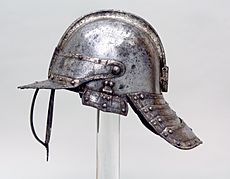
Royalist cavalry had similar gear. However, many Scottish horse soldiers used lances instead of pistols. Scottish horses were smaller and faster. Parliamentarian cavalry rode very close together to charge. Royalist cavalry often charged faster but in looser groups.
Dragoons and Cannons
Both armies also had dragoons. These were soldiers who rode horses to move quickly. But they would get off their horses to fight. They usually carried muskets or shorter guns called carbines. Dragoons often acted as scouts or protected the army's rear.
Cannonballs found at the battle site suggest that some light cannons were used.
Most Parliamentarian soldiers were experienced fighters. The Scottish army, however, had many new recruits. Many of them lacked training.
The Road to Winwick
The Battle of Preston
On 8 July, the Scottish army, led by the Duke of Hamilton, entered England. They joined with English Royalists. The combined force slowly moved south.
By 17 August, part of their army reached Wigan. But the army was spread out over 50 miles. Meanwhile, Oliver Cromwell had joined the Parliamentarian forces. He took command.
On the morning of 17 August, the Scottish foot soldiers were near Preston. The English Royalists were fighting Parliamentarian scouts. The Duke of Hamilton focused on getting his Scottish foot soldiers across the Ribble bridge.
The Parliamentarians attacked the Royalists near Preston. After four hours of fierce fighting, the Parliamentarians broke through. They cut off Royalist forces north of the river. They also captured the bridge after two hours of hard fighting. By the end of the day, about 1,000 Royalists were dead and 4,000 captured.
The Difficult Retreat
The Scottish leaders south of the river decided to retreat immediately. They wanted to get away from Cromwell's army. To move fast, they left behind their supplies and ammunition.
The Parliamentarians quickly pursued them. About 2,500 Parliamentarian horse soldiers chased the Scots. They wanted to force the Scottish foot soldiers to stop and fight.
Throughout 18 August, the Parliamentarians kept up the pressure. The Scots were tired, hungry, cold, and wet. Many had no dry gunpowder. They kept moving south, leaving behind stragglers and deserters. One soldier wrote that the roads were "littered with the dead."
The Fight at Winwick
A Strong Defense
On the morning of 19 August, the Scots stopped near Newton and Winwick. They found a good defensive spot where the road crossed Hermitage Brook. There was a large bank, called "Red Bank," and many hedges. The ground was also very muddy.
The Scots prepared for battle. They placed pikemen at the ford (a shallow crossing point) and musketmen along the hedges. Their horse soldiers continued to Warrington, about 3 miles south. The plan was for the horse soldiers to secure the bridge there. This would give the foot soldiers time to cross safely.
The Scottish horse soldiers did cross the bridge at Warrington. They even built some defenses. But this made it risky for the foot soldiers to follow.
Fierce Fighting
The Scots had about 4,000 to 6,000 foot soldiers. The Parliamentarians had about 5,400 to 5,500 men. The Parliamentarian horse soldiers arrived first. They were so tired they could only walk. The Scots attacked their advance guard, forcing them to retreat.
There was a long pause as the Parliamentarian foot soldiers arrived. They tried to attack the Scottish positions but were pushed back. More Parliamentarian foot soldiers arrived, and the attack continued.
The fighting was very fierce for over three hours. Both sides fought hard. The Parliamentarians charged repeatedly, but the Scots held their ground.
By this time, the Scottish musketmen had run out of gunpowder. This was because they had left their supplies at Preston. Also, the heavy rain had made much of their powder wet.
The Scots Surrender
The Parliamentarian foot soldiers pulled back. Their horse soldiers kept the Scots in place. If the Scots tried to retreat, the horse soldiers would attack them from behind.
During this time, the Parliamentarian foot soldiers took a long route around some woods. They appeared on the side and behind the Scots. Local people helped the Parliamentarians find the best way to do this.
When the Scots saw the enemy appearing on their right side, they broke and ran. They were exhausted. About half of them fled towards Winwick. Parliamentarian horse soldiers chased them, killing many.
The Scots threw away their weapons and crowded into Winwick church. There, they were taken prisoner. The rest of the Scottish foot soldiers, fewer than 2,600 men, followed their horse soldiers to Warrington. The fighting at Winwick cost the Scots 1,000 killed and 2,000 captured.
When the Scottish foot soldiers reached Warrington, they found that their horse soldiers and commander had left them. The Duke of Hamilton had left a message telling them to surrender. The Scottish infantry commander, William Baillie, was so upset he asked his staff to shoot him.
The Scots at Warrington barricaded the bridge and surrendered. Cromwell took them prisoner. He spared their lives and allowed them to keep their personal belongings. Cromwell said the victory at Winwick was "nothing but the hand of God."
What Happened Next
The End of the War
About 2,500 to 3,000 Scottish horse soldiers headed south. They were attacked by local militias. Their discipline broke down, and many soldiers deserted. The commander of the Scottish cavalry was captured.
At Uttoxeter on 24 August, the Scots refused to march any further. The Duke of Hamilton was too sick to move and surrendered to the Parliamentarians. This completed the destruction of the Royalist army.
Many of the captured Scottish soldiers were sold as slaves. Some were sent to work in the Americas. Others became galley slaves for Venice. The Duke of Hamilton was executed for treason in March 1649.
The Parliamentarians reported very few losses. Modern historians believe more were killed or wounded, possibly over 500.
England Becomes a Republic
The Battle of Winwick was the last battle of the Second English Civil War. After hearing about the victory, the Royalist forces at Colchester surrendered. This effectively ended the war.
The defeat of the Scottish army caused big changes in Scotland. The group that opposed the "Engagement" gained control of the government.
In England, Parliament was divided. The army, especially the New Model Army, was frustrated. They took control of Parliament, removing members who disagreed with them. This new Parliament, called the Rump Parliament, put King Charles I on trial.
He was found guilty of treason against the English people. On 30 January 1649, King Charles I was beheaded. On 19 May, England became a republic. This meant it was ruled by Parliament, not a king.
The King's Son and More War
The Scottish Parliament had not been asked about the King's execution. They declared his son, Charles II, to be the new King of Britain. Charles II sailed to Scotland.
The Scots began to raise a new army to support King Charles II. The English leaders felt threatened by this. So, the New Model Army, led by Cromwell, invaded Scotland on 22 July 1650.
After 14 months of fighting, Scotland was mostly under English control. A Scottish counter-invasion was crushed at the Battle of Worcester. Charles II was one of the few to escape into exile.
The Scottish government was dissolved. Scotland became part of the English Commonwealth. English troops were stationed across Scotland to keep peace.
After some disagreements within the English Parliament and army, Cromwell ruled England as Lord Protector. He ruled from December 1653 until his death in September 1658.
In 1660, new elections were held. The new Parliament declared that Charles II had been the rightful king since his father's execution. Charles II returned from exile and was crowned king in 1661. This event is known as the Restoration.
The Battlefield Today
The site of the Battle of Winwick was officially recognized as a historic battlefield in 2018. It is one of only 47 battlefields in England considered "nationally significant." It is also noted as being "the only English battlefield of the Second Civil War which remains in a good state of preservation."
The "Red Bank" and the battle site have been on maps since 1849. In 1648, the area was mostly open land with woods and marshy valleys. Over time, farming, mining, and road building have changed the landscape. There are also houses built around the edges of the site.
However, the path of the Hermitage Brook and the Red Bank can still be clearly seen today.
Images for kids


